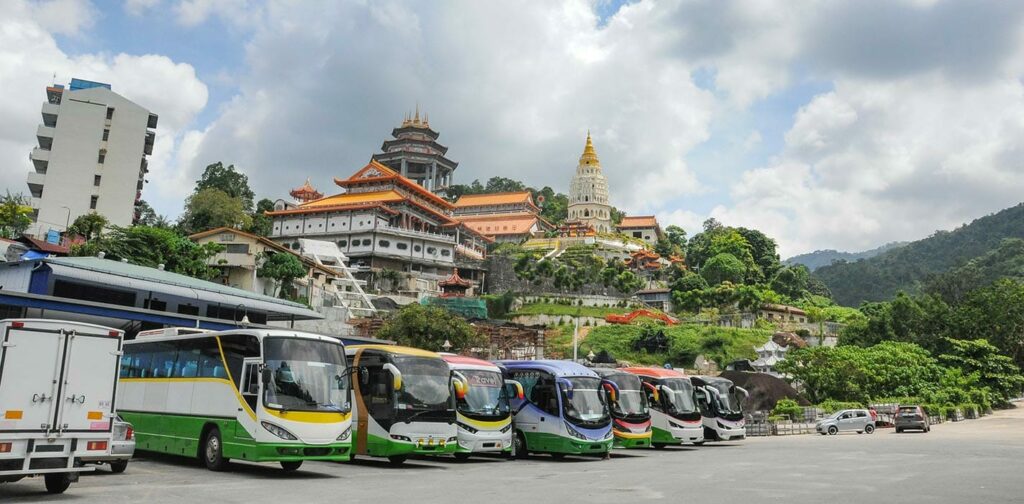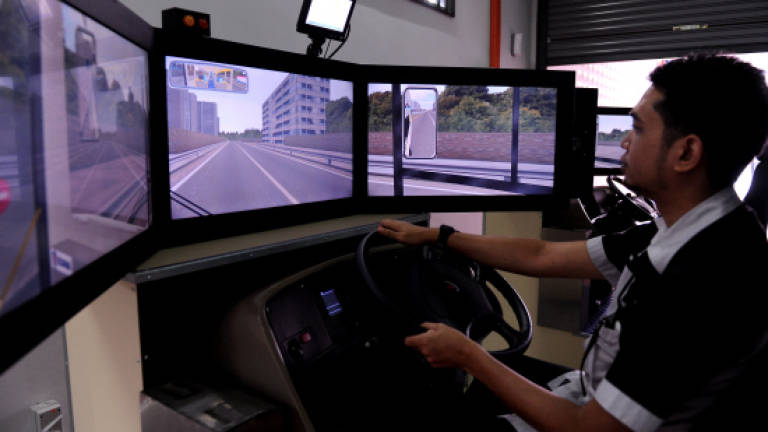
Malaysia’s tourism industry relies heavily on the transportation sector, with tour buses playing a crucial role in transporting tourists to various destinations. However, Malaysian tour operators has led to several problems especially in getting bus drivers.
Due to COVID-19 pandemic, with travel restrictions and lockdowns leading to a significant decline in tourism. One of the challenges faced by the industry is a shortage of tour bus drivers, with many local drivers changing careers due to the economic impact of the pandemic.
Estimate more than 6,000 tour busses on the road ( refer to the table below )


Through MITA’s survey as of 26th January , there are 265 tour busses companies who are looking for 2,000 tour bus drivers to be employed .
This is a major problem ! The shortage of tour bus drivers is becoming a major concern for the tourism industry, as it can lead to a number of problems that can negatively impact the industry.
One of the major problems that can arise from the shortage of tour bus drivers is a reduction in the number of tours and excursions that are offered. This can result in a decrease in the number of tourists that are able to visit a particular destination, which can have a significant impact on the local economy. This can cause a negative ripple effect, leading to a decrease in revenue for local businesses and a loss of jobs in the community.
Another problem that can arise from the shortage of tour bus drivers is an increase in the cost of tours and excursions. With fewer drivers available, tour operators may have to pay higher wages to attract and retain drivers, which can lead to an increase in the cost of tours and excursions. I was told that some of the tour bus drivers demand at least 20% of tour bus sales . This will add on more to the cost of the ground handling package.
As the result , it can make our ground packages less affordable for tourists, leading to a decrease in demand for these services.
The shortage of tour bus drivers can also lead to a decrease in the quality of service that tourists receive. With fewer drivers available, tour operators may have to rely on less experienced or less qualified drivers, which can lead to a decrease in the quality of service that tourists receive. This can result in a negative experience for tourists, which can lead to a decrease in repeat business and a negative reputation for the destination.
so what is the SOLUTION ???

I personally think to address this problem, it’s important to consider both short-term and long-term solutions.
SHORT TERM SOLUTION :
One of the most immediate solutions to the problem of tour bus driver shortages is to bring in foreign workers as tour bus drivers. This can help to fill the gap in the short-term and ensure that the tourism industry can continue to operate smoothly. However, it’s important to weigh the potential benefits and drawbacks of this solution, and put in place the necessary measures to ensure that it is viable and sustainable.
There are so many debates on getting foreign workers as tour bus drivers . I can understand the concerns of Rakyat Malaysia and some of the travel players.
Some even gave an unrealistic feedback such as ” PEKERJA ASING NI BUSUK AND KENA GUNA PERFUME YANG BANYAK UNTUK SPRAY DALAM BAS ” That was actually an uncalled excuse.
However, I do agree the fact that hiring of foreign tour bus drivers by Malaysian tour operators has led to other several problems such as belows:
Language barriers can create communication difficulties between the driver , tour guide and even tourists, leading to confusion and dissatisfaction. This can also be a safety concern, as the driver may not be able to understand or communicate important instructions or information.
Another issue is that foreign drivers may not be familiar with the local laws and regulations, which can lead to legal problems and fines. They may also not be familiar with the roads and traffic conditions, which can lead to accidents and delays.
The hiring of foreign drivers also raises concerns about the employment opportunities for local drivers. Many Malaysian drivers feel that they are being pushed out of the industry by the influx of foreign drivers who are willing to work for lower wages.
.. but again , many players feel that there is no other realistic short term solution other than getting foreign workers as tour bus driver.
Through or survey recently , in order to overcome this shortage ; it’s important for the government of Malaysia to consider allowing travel agents to bring in foreign workers as tour bus drivers. There are some advantages when we employ the foreign workers as tour bus drivers for short term.
It will open up more job opportunities for locals. The tourism industry is closely related to many other industries and by allowing more foreign tour bus drivers, it will increase the demand for other services like accommodation, food and beverages, and transportation. This will create more job opportunities for locals in these industries, and will help to boost the local economy.
Furthermore, bringing in foreign tour bus drivers can also serve as a catalyst for the locals to improve their skills and knowledge in the field of tourism, as they can learn from the foreign workers and gain new perspectives. This will help to improve the overall quality of service in the tourism industry, and will attract more tourists to Malaysia in the future.
In addition, by allowing more foreign workers as tour bus drivers, it will also help to increase the diversity of the tourism industry, making it more inclusive and welcoming to tourists from different backgrounds. This will help to boost the reputation of Malaysia as a tourism destination, and will attract more tourists in the future.
Allowing travel agents to bring in foreign workers as tour bus drivers can not only provide a solution to the shortage of tour bus drivers in Malaysia, but also open up more job opportunities for locals, and improve the overall quality of service in the tourism industry. It will also help to boost the reputation of Malaysia as a tourism destination and attract more tourists in the future. The government of Malaysia should collaborate with MITA to provide training for foreign workers and ensure that the process is done in compliance with laws and regulations.
Here are some key points to consider why we should implement this short term solution:
- Lack of local tour bus drivers: The COVID-19 pandemic has led to a significant decline in tourism and a corresponding decline in the number of tour bus drivers. Many local drivers have changed careers due to the economic impact of the pandemic.
- Foreign workers can fill the gap: Allowing travel agents to bring in foreign workers as tour bus drivers can help to overcome the shortage of local drivers and ensure that the tourism industry can continue to operate.
- Experienced and qualified: Many foreign workers who are interested in working as tour bus drivers in Malaysia are experienced and qualified professionals who have worked in the industry for many years.
- Language skills: Some foreign workers may also have language skills that can be of great benefit to the tourism industry in Malaysia, helping to communicate with tourists from different countries and backgrounds.
- Contributes to the economy: By allowing travel agents to bring in foreign workers as tour bus drivers, the government of Malaysia can help to ensure that the tourism industry continues to contribute to the economy by providing jobs and income.
- Cost-effective solution: Allowing travel agents to bring in foreign workers as tour bus drivers can be a cost-effective solution for the tourism industry, as travel agents can handle the process of recruiting and hiring foreign workers.
- Carefully selected: Travel agents can carefully select qualified and experienced foreign workers who will be able to perform the duties of a tour bus driver effectively
. - Compliance with laws and regulations: It’s important for the government to make sure that travel agents comply with all relevant laws and regulations when bringing in foreign workers, to ensure the safety and well-being ofthe workers and the tourists they will be transporting. This includes providing proper accommodation and fair compensation, as well as ensuring compliance with immigration laws.
- Cultural sensitivity: Foreign workers should be trained in cultural sensitivity and understanding of the local customs and culture in Malaysia, to ensure that they provide a high level of service to tourists and act as ambassadors for the country.
- Safety and security: The government must ensure that foreign workers meet the necessary safety and security standards for operating tour buses in Malaysia.
Therefore in view of the above points , Malaysian Inbound Tourism Association (MITA) can play a key role in providing proper training for foreign bus drivers. MITA can ensure that foreign workers are properly trained and equipped to provide a high level of service to tourists and to operate tour buses safely and efficiently.
This includes providing training on local laws and regulations, as well as training on cultural sensitivity and understanding of local customs and culture. MITA can also provide training on the specific routes and destinations that the tour buses will be operating in, as well as training on proper vehicle maintenance and safety procedures.
By providing proper training for foreign bus drivers, MITA can ensure that the tourism industry in Malaysia continues to operate smoothly and safely, while providing a positive experience for tourists. This will in turn help to maintain a positive image of Malaysia as a tourist destination and will attract more tourists in the future.
In addition, providing proper training will also help to ensure that foreign workers are fully prepared to perform their duties as tour bus drivers and can be a valuable asset to the tourism industry in Malaysia. The government of Malaysia should support and collaborate with MITA to provide training for foreign workers as tour bus drivers.
What about LONG TERM SOLUTION ?

While bringing in foreign workers can help in the short-term, it is not a long-term solution. In order to address the underlying issues that are causing the shortage of drivers, it’s important to consider long-term solutions.
One of the most effective long-term solutions is to offer incentives to attract and retain drivers. This can include higher wages, benefits, and training programs to make the job more attractive to local workers. Providing more opportunities for career advancement for drivers, such as training programs and leadership development, can also help to retain drivers and attract new ones.
Another important solution is to encourage more young people to pursue careers as tour bus drivers, by targeted education and outreach efforts. By creating a pipeline of future drivers, the shortage of tour bus drivers can be mitigated in the long-term.

Finally, investing in technology such as autonomous buses can also help to mitigate the effects of the driver shortage in the long-term. This technology is still in the early stages of development, but as it advances, it could potentially help to reduce the need for human drivers.
In summary :
Short-term Solutions:
One of the most immediate solutions to the problem of tour bus driver shortages is to bring in foreign workers as tour bus drivers. This can help to fill the gap in the short-term and ensure that the tourism industry can continue to operate smoothly. However, it’s important to weigh the potential benefits and drawbacks of this solution, and put in place the necessary measures to ensure that it is viable and sustainable.
Long-term Solutions:
- Offering incentives to attract and retain drivers: This can include higher wages, benefits, and training programs to make the job more attractive to local workers.
- Providing more opportunities for career advancement for drivers: Offering training programs and leadership development can help to retain drivers and attract new ones.
- Encouraging more young people to pursue careers as tour bus drivers: Targeted education and outreach efforts can help to create a pipeline of future drivers.
- Investing in technology: Autonomous buses can help to mitigate the effects of the driver shortage in the long-term.
wait .. wait !!!! …..some of you may notice on number 4 solution …AUTONOMOUS BUSSES ??
What the heck is that ???
For your information , Autonomous buses, also known as self-driving buses or driverless buses, are buses that are equipped with technology that allows them to operate without a human driver. This technology includes a combination of sensors, cameras, GPS, and advanced algorithms that allow the bus to navigate and make decisions on its own.

The most advanced autonomous buses are able to navigate through complex traffic situations, make lane changes, and avoid obstacles without human input. They can also communicate with other vehicles and traffic infrastructure, such as traffic lights, to optimize their routes and improve safety.
There are several benefits to using autonomous buses. One of the most significant benefits is that they can help to reduce the need for human drivers, which can help to mitigate the effects of the driver shortage in the transportation industry. They can also improve safety by reducing the likelihood of human error, which is a common cause of accidents.
Additionally, autonomous buses can also be more efficient than traditional buses, as they can navigate through traffic more quickly and make more precise maneuvers. This can help to reduce travel times and improve the overall efficiency of the transportation system.
Currently, several countries are testing and implementing autonomous buses on the road, such as Singapore, China, and several European countries. However, the technology is still in the early stages of development, and widespread adoption may take some years.
WOWW !! When can we expect it on the road ?
It is difficult to predict exactly when driverless buses will be on the roads of Malaysia, as it depends on a number of factors such as the availability of the technology, the readiness of the infrastructure, and the regulatory environment.
However, I was told that the Government of Malaysia has shown interest in the implementation of autonomous vehicle technology and have been taking steps to promote the development and implementation of autonomous vehicles in the country. The government is also working on creating a regulatory framework for autonomous vehicles and is considering pilot projects to test the technology in real-world scenarios.
It is likely that we will see pilot projects of autonomous buses in Malaysia in the near future, but widespread deployment of the technology will likely take several more years. It also depends on the level of autonomy, as lower level of autonomy can be implemented earlier than higher level of autonomy.
It’s worth noting that the deployment of autonomous buses will require a significant investment in technology and infrastructure, as well as the development of the necessary regulations and guidelines. The progress will also depend on the readiness of the local industry and the availability of local talent to support the development and deployment of the technology.
It is likely that we will see pilot projects of autonomous buses in Malaysia in the near future, but widespread deployment of the technology will likely take several more years. It’s also depend on the level of autonomy and the readiness of the local industry and the availability of local talent.
Some of the countries that have made significant progress in this area include:
- Singapore: Singapore has been a leader in the development and deployment of autonomous vehicles, and has been testing autonomous buses since 2016. They have already deployed several autonomous buses on public roads, and plans to expand the fleet in the coming years.
- Netherlands: The Netherlands has been testing autonomous buses in the city of Amsterdam since 2018, and plans to expand the fleet in the coming years. The city of Eindhoven has also been testing autonomous buses in the city center since 2019.
- China: China has been testing autonomous buses in several cities, including Beijing, Shanghai, and Guangzhou. They have already deployed several autonomous buses on public roads and have plans to expand the fleet in the coming years.
- France: In France, several cities have been testing autonomous buses, such as Rouen, Strasbourg, and La Rochelle. The French government has also been working on developing a regulatory framework for autonomous vehicles.
- United States: The United States has been testing autonomous buses in several cities, including Las Vegas, Houston, and San Ramon. Companies like Waymo and Tesla have also been working on developing autonomous bus technology.
Singapore has started it ..
even in China too..
I’m not sure when can we will see it happening in Malaysia but we have to prepare for this disruption.
Therefore , It’s important to have a combination of short and long-term solutions to tackle the issue of shortage of tour bus drivers.
In the short term, bringing in foreign workers as tour bus drivers can help to fill the gap and ensure that the tourism industry continues to operate smoothly.
However, in the long-term, it’s important to address the underlying issues that are causing the shortage of drivers, by offering incentives, providing opportunities for career advancement, and investing in technology.
P.S : MITA’s survey on Foreign Workers for Tour Bus Drivers is still on going . For travel agents who require the bus drivers , please fill in the form at https://form.jotform.com/malaysiatourism/busdrivers
